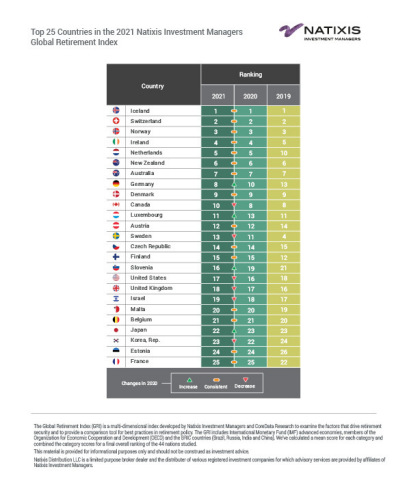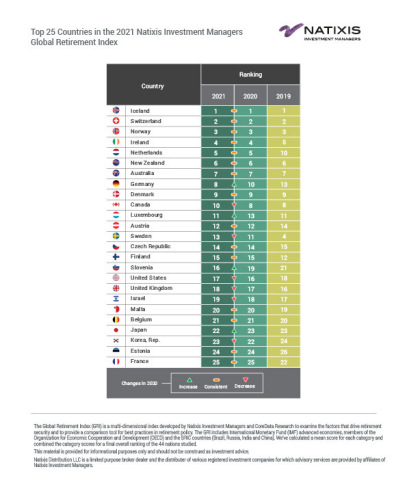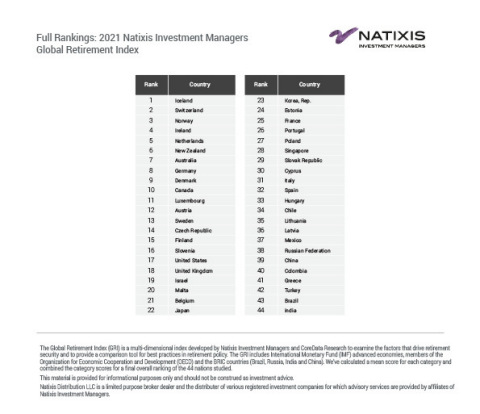BOSTON--(BUSINESS WIRE)--The United States slipped one spot to No. 17 among developed nations in the 2021 Global Retirement Index (GRI), released today by Natixis Investment Managers (Natixis IM). The ninth annual index, a snapshot of the relative financial security of retirees in 44 countries, shows that many Americans feel that their retirement dreams are slipping away, notably as a result of the macro-economic consequences of the COVID-19 pandemic including increased government debt, rising inflation and persistently low interest rates. Savers are shouldering a growing share of the responsibility for funding their retirement and are increasingly looking to the private sector and financial advisors for help.
In a survey of 750 US individual investors, Natixis Investment Managers found:
- Overall, 41% of respondents, including 46% of Generation Y, 45% of Generation X and 30% of Baby Boomers, believe they will need a miracle to be able to retire securely;
- While 73% recognize it is increasingly their responsibility to fund retirement versus relying on a pension or Social Security, 42% say it will be difficult to make ends meet if Social Security benefits are lower than expected, including 31% of those with a net worth of $1 million or more;
- Nearly six in 10 (59%) accept that they will have to keep working for longer, while 36% believe they will never have enough money to retire, including 51% of Generation Y, 48% of Generation X and one in five Baby Boomers (20%)
- Two-thirds (68%) see long-term inflation as one of the biggest risks to their retirement security, while 64% worry that healthcare costs will eat up their savings.
- Half (50%) are concerned that low interest rates will make it harder to generate income in retirement.
“The pandemic has exacerbated financial inequality and accelerated long-term trends that are eroding the prospect of retirement security for many,” said Jim Roach, Senior Vice President of Retirement Strategies at Natixis Investment Managers. “As policymakers look to normalize fiscal and economic policy in the wake of the pandemic, Natixis Investment Managers’ Global Retirement Index provides insight into the factors having the greatest impact on retirement security around the world.”
The GRI examines 18 performance indicators of retiree welfare grouped into four thematic sub-indices, namely:
- Material Wellbeing - the material means to live comfortably in retirement;
- Finances in Retirement - access to quality financial services to help preserve savings value and maximize income;
- Health - access to quality health services; and
- Quality of Life - a clean, safe environment in which to live.
The GRI calculates the performance for each country on these criteria, resulting in a composite score that provides a comparative tool for evaluating retirement security globally, as well as identifying drivers of changes in each country’s score and ranking.
2021 Global Retirement Index: A global view of retiree wellbeing
- The Top Ten: The 2021 Global Retirement Index puts Iceland in first place overall for the third consecutive year. The next six countries—Switzerland, Norway, Ireland, Netherlands, New Zealand, and Australia—have the same rankings as last year, but all with slightly lower scores than the previous year. Germany moved up two places to No. 8, swapping places with Canada which slipped to No. 10 while Denmark held on to its place at No. 9. All of the top ten countries in the Index are characterized by either balanced performance across all four sub-indices or particularly strong performance in at least three sub-indices to make up for lagging performance in another.
- The Top 25: Fifteen of the top 25 countries have the same overall ranking as last year, and 19 are in the Europe, Middle East and Africa (EMEA) region. No new countries entered or exited the top 25, and movement up or down is mainly limited to changes of two spots or fewer. Slovenia is the only country among the top 25 to move three places, improving to No. 16 from No. 19 last year and up from No. 21 in 2019. Luxembourg moves up two spots to 11th while Sweden moves down two places to 13th. The US, UK, Israel, and South Korea all slip down one spot to 17th, 18th, 19th and 23rd respectively while Japan moves up one place in the rankings to 22nd.
- Sub-Indices: The top ranking countries by sub-index are Iceland for Material Wellbeing, Singapore for Finances in Retirement, Japan for Health and Finland for Quality of Life. Four of the five top-ranked countries for Quality of Life are Nordic countries.
Factors Affecting the US GRI Ranking
The US ranked 17th overall in the 2021 Global Retirement Index, placing No. 11 for Finances in Retirement; No.17 in Health; No. 21 in Quality of Life and No. 26 in Material Wellbeing.
The US had lower scores in three of four sub-indices, including:
- Finances in Retirement, driven by lower scores in tax pressure, old-age dependency, governance, government indebtedness and bank nonperforming loans;
- Health, due to a lower score in life expectancy; and
- Quality of Life, as a result of lower scores in happiness and environmental factors.
In Material Wellbeing, the only sub-index in which the US does not rank among the top 25 nations, it scored slightly higher for income per capita and income equality. Among all the GRI countries in the Index, the US has the highest health expenditure per capita, the sixth highest income per capita and the sixth lowest score for government indebtedness. Meanwhile, 56% of US investors surveyed by Natixis IM, including 64% of Generation Y and 62% of Generation X, believe that income inequality has a detrimental impact on overall retirement security in the US.
Public policy and the private sector opportunity in a world looking beyond COVID
In response to the COVID-19 pandemic, governments around the world rolled out massive fiscal stimulus packages, cut or froze interest rates, and flooded the capital markets with unprecedented liquidity. Yet even as these policy actions helped spur recovery and growth, particularly in the US, they represent a significant long-term risk to retirees who are especially vulnerable to low yields and face the challenge of generating a sustainable income in retirement.
“The challenge is compounded as retirees invest in riskier assets to generate the returns they need at a point in life when they may not have the time to recoup potential losses,” said Dave Goodsell, Executive Director, Natixis IM Center for Investor Insight. “Fortunately for today’s policy makers, low interest rates make debt more manageable. However, growing levels of public debt and the need to find budgetary solutions will force tough decisions about government spending, including public retirement benefits, raising taxes, raising the retirement age, and cutting benefits.”
Natixis IM’s survey found that in the US, 83% of investors remain confident they can securely retire and are working toward that goal. On average, they are saving 18% of their current income for retirement. Should government benefits, workplace savings, and personal savings come up short, many Americans believe the answer is simply to work longer. Yet 39% worry they won’t be able to stay employed even if they wanted to.
One-third (34%) of investors think that retirement might never be an option, including 40% of millennials and one in four (25%) Baby Boomers. The conundrum is so great that nearly half (49%) avoid thinking about their retirement security altogether. More worrisome is that these findings represent a population of investors with a median net worth of $450,000, who have accumulated a median of $350,000 in savings for retirement, far more than the median of $65,000 saved for retirement by the general US population. 1
The survey also highlights the opportunity that exists for the private sector, namely employers and financial advisors, to play a role:
- Eight in 10 (82%) US investors believe that employers have a responsibility to help their employees achieve a financially secure retirement.
- Nearly eight in 10 (79%) would prefer to work for a company that offers a retirement plan savings match.
- Six in 10 (63%) investors say they need professional help with selecting investments in their workplace retirement plan, which 36% of Baby Boomers and at least one in five younger investors say they do not understand.
- Younger investors, including 73% of Generation Y and 65% of Generation X, are most likely to say they need professional financial advice, compared to 57% of Baby Boomers.
- Two-thirds (67%) of investors say they would be motivated to invest more for retirement if they had access to investments that are more closely aligned with their priorities and values.
A report on the 2021 Global Retirement Index explores in-depth these findings and other factors affecting retirement security globally. Please find the full report here.
Methodology
The Global Retirement Index assesses factors that drive retirement security across 44 countries where retirement is a pressing social and economic issue. It was compiled by Natixis Investment Managers with support from CoreData Research. The index includes International Monetary Fund (IMF) advanced economies; members of the Organization for Economic Cooperation and Development (OECD); and the BRIC countries (Brazil, Russia, India and China). The researchers calculated a mean score in each category and combined the category scores for a final overall ranking of the 44 nations studied.
About the Natixis Investment Institute
The Natixis Investment Institute applies Active Thinking® to critical issues shaping the investment landscape. A global effort, the Institute combines expertise in the areas of investor sentiment, macroeconomics, and portfolio construction within Natixis Investment Managers, along with the unique perspectives of our affiliated investment managers and experts outside the greater Natixis organization. Our goal is to fuel a more substantive discussion of issues with a 360° view of markets and insightful analysis of investment trends.
About Natixis Investment Managers
Natixis Investment Managers’ multi-affiliate approach connects clients to the independent thinking and focused expertise of more than 20 active managers. Ranked among the world’s largest asset managers1 with more than $1.4 trillion assets under management2 (€1,182.5 billion), Natixis Investment Managers delivers a diverse range of solutions across asset classes, styles, and vehicles. The firm is dedicated to advancing sustainable finance and developing innovative Environmental, Social, and Governance (ESG) products. Natixis Investment Managers consults and partners with its clients and offers insight on markets and assumptions to better align strategies with long-term goals.
Headquartered in Paris and Boston, Natixis Investment Managers is wholly-owned by Natixis. Natixis is a subsidiary of BPCE, the second-largest banking group in France. Natixis Investment Managers’ affiliated investment management firms include AEW; Alliance Entreprendre; AlphaSimplex Group; DNCA Investments;3 Dorval Asset Management; Flexstone Partners; Gateway Investment Advisers; Harris Associates; Investors Mutual Limited; Loomis, Sayles & Company; Mirova; MV Credit; Naxicap Partners; Ossiam; Ostrum Asset Management; Seeyond; Seventure Partners; Thematics Asset Management; Vauban Infrastructure Partners; Vaughan Nelson Investment Management; and WCM Investment Management. Additionally, investment solutions are offered through Natixis Investment Managers Solutions and Natixis Advisors, LLC. Not all offerings available in all jurisdictions. For additional information, please visit Natixis Investment Managers’ website at im.natixis.com | LinkedIn: linkedin.com/company/natixis-investment-managers.
Natixis Investment Managers’ distribution and service groups include Natixis Distribution, LLC, a limited purpose broker-dealer and the distributor of various U.S. registered investment companies for which advisory services are provided by affiliated firms of Natixis Investment Managers, Natixis Investment Managers S.A. (Luxembourg), Natixis Investment Managers International (France), and their affiliated distribution and service entities in Europe and Asia.
1 Cerulli Quantitative Update: Global Markets 2021 ranked Natixis Investment Managers as the 15th largest asset manager in the world based on assets under management as of December 31, 2020.
2 Assets under management (“AUM”) as of June 30, 2021 is $1,402.5 billion. AUM, as reported, may include notional assets, assets serviced, gross assets, assets of minority-owned affiliated entities and other types of non-regulatory AUM managed or serviced by firms affiliated with Natixis Investment Manager. Excluding H2O Asset Management.
3 A brand of DNCA Finance.
3746483.1.1





